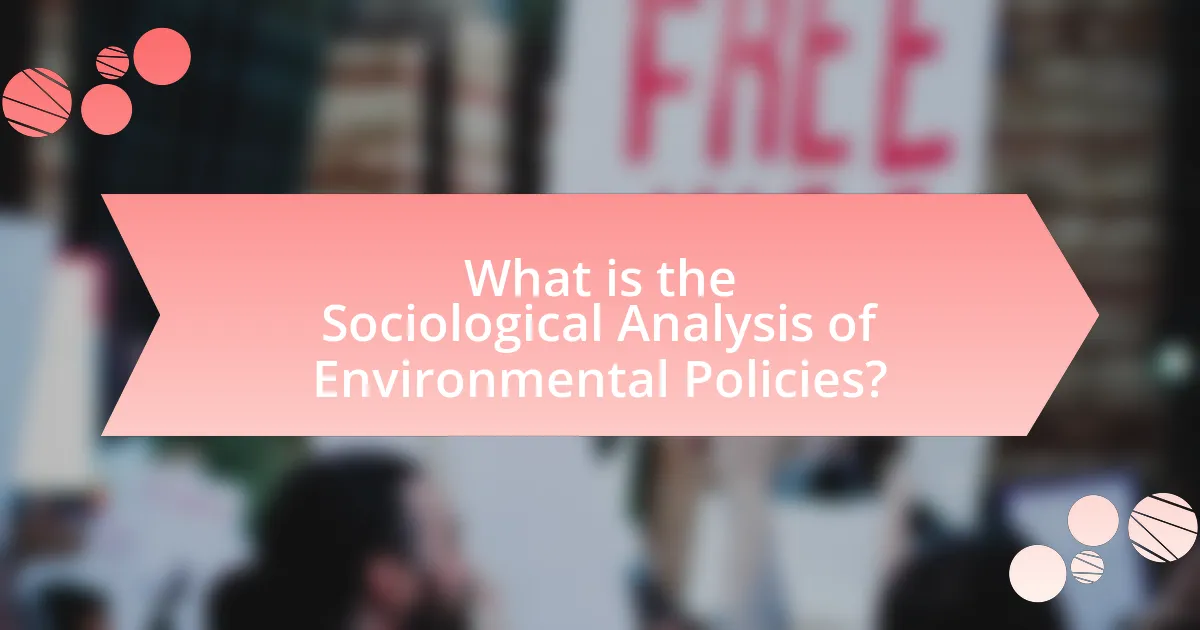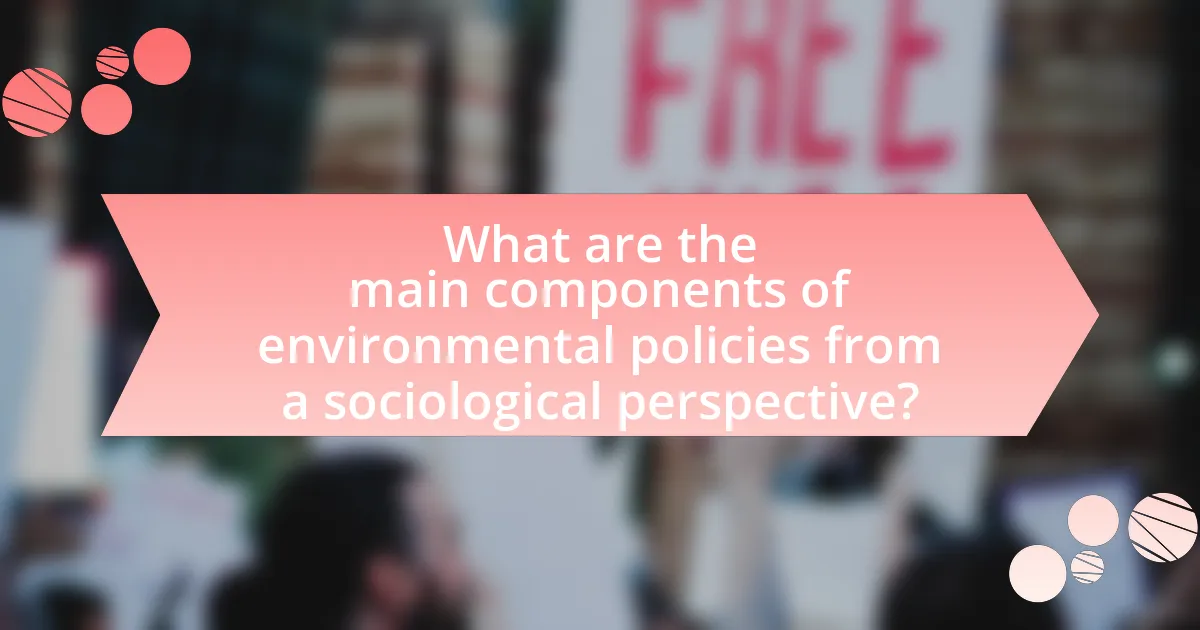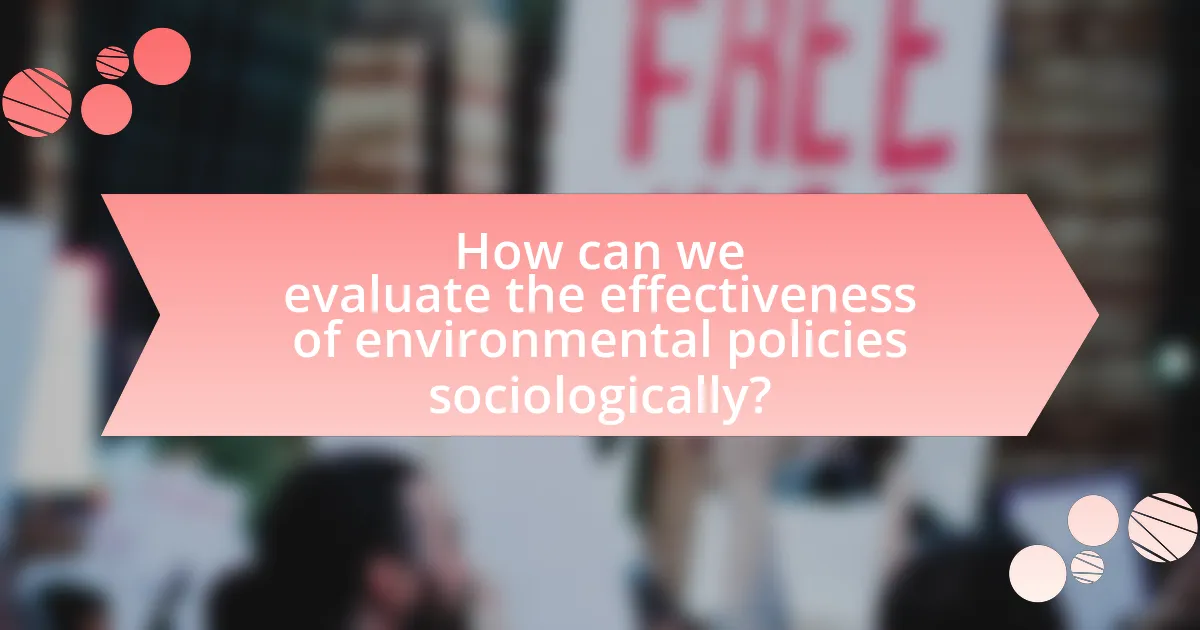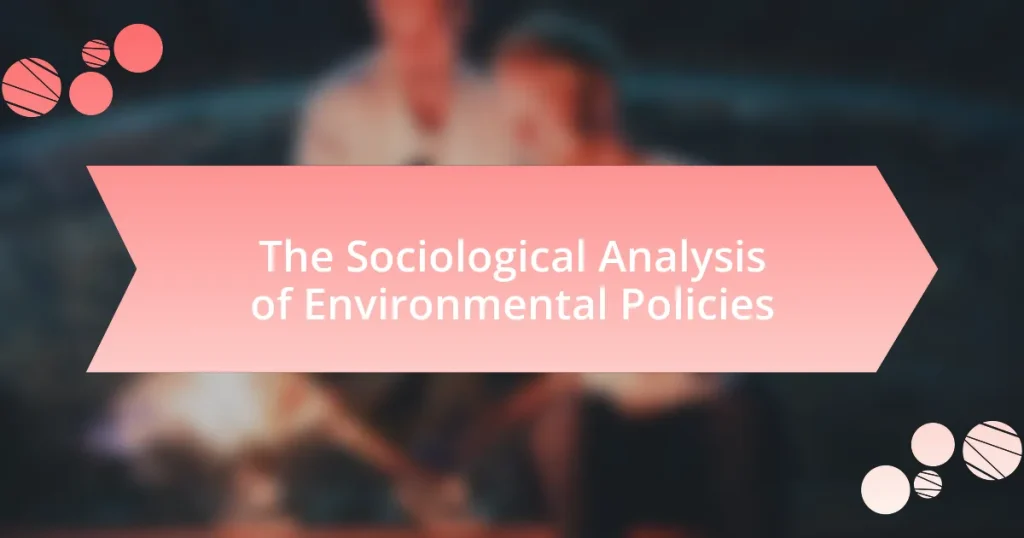The sociological analysis of environmental policies investigates the interplay between social structures, relationships, and cultural norms in shaping environmental governance. It emphasizes that environmental policies are influenced by social contexts, highlighting issues of equity, community engagement, and stakeholder dynamics. Key sociological theories, such as the Social Construction of Nature and Political Ecology, provide frameworks for understanding how power dynamics and cultural values affect policy effectiveness. The article also discusses the importance of public perception, the role of various stakeholders, and the social implications of environmental policies, underscoring the need for inclusive approaches to achieve equitable and sustainable outcomes.

What is the Sociological Analysis of Environmental Policies?
The sociological analysis of environmental policies examines how social structures, relationships, and cultural norms influence the formulation, implementation, and effectiveness of these policies. This analysis reveals that environmental policies are not solely technical or scientific decisions; they are deeply embedded in social contexts that shape public perceptions, stakeholder interests, and power dynamics. For instance, research shows that marginalized communities often face disproportionate environmental burdens, highlighting the need for policies that address social equity alongside environmental sustainability. Studies, such as those by the United Nations Environment Programme, emphasize the importance of integrating social considerations into environmental governance to achieve more effective and just outcomes.
How do sociological perspectives shape our understanding of environmental policies?
Sociological perspectives shape our understanding of environmental policies by highlighting the social contexts, power dynamics, and cultural values that influence environmental decision-making. For instance, the structural-functional perspective emphasizes how environmental policies serve to maintain social order and stability, while the conflict perspective reveals how these policies often reflect the interests of powerful groups, leading to inequalities in environmental protection. Additionally, the symbolic interactionist perspective focuses on how individuals and communities interpret and respond to environmental issues, shaping grassroots movements and public perceptions. Research shows that policies are more effective when they consider these sociological factors, as evidenced by studies indicating that community engagement in policy-making leads to better environmental outcomes (e.g., the work of Dietz et al. in “Public Understanding of Science”).
What are the key sociological theories relevant to environmental policy analysis?
Key sociological theories relevant to environmental policy analysis include the Social Construction of Nature, Ecological Modernization Theory, and Political Ecology. The Social Construction of Nature posits that environmental issues are shaped by social processes and cultural perceptions, influencing how policies are formulated and implemented. Ecological Modernization Theory suggests that economic growth and environmental protection can be reconciled through technological innovation and policy reform, emphasizing the role of institutions in facilitating sustainable practices. Political Ecology examines the power dynamics and social inequalities that affect environmental governance, highlighting how marginalized communities are often disproportionately impacted by environmental policies. These theories provide a framework for understanding the complex interplay between society and the environment, guiding effective policy analysis and development.
How do social structures influence environmental policy decisions?
Social structures significantly influence environmental policy decisions by shaping the values, norms, and power dynamics within a society. For instance, communities with strong environmental advocacy groups often push for stricter regulations and sustainable practices, leading to policies that prioritize ecological preservation. Research indicates that social capital, defined as the networks and relationships among people, can enhance collective action for environmental initiatives, as seen in studies like “Social Capital and Environmental Policy” by Putnam (1993), which highlights how civic engagement correlates with effective environmental governance. Additionally, socioeconomic status affects access to resources and political influence, thereby impacting which environmental issues are prioritized in policy-making.
Why is it important to analyze environmental policies sociologically?
Analyzing environmental policies sociologically is important because it reveals the social dynamics, power structures, and cultural values that influence policy formation and implementation. This sociological perspective helps to understand how different communities are affected by environmental issues, as evidenced by studies showing that marginalized groups often bear a disproportionate burden of environmental hazards. For instance, research by the Environmental Justice Foundation highlights that low-income communities frequently face higher exposure to pollution due to systemic inequalities in policy decisions. By examining these social factors, policymakers can create more equitable and effective environmental strategies that address the needs of all societal segments.
What role does public perception play in the formulation of environmental policies?
Public perception significantly influences the formulation of environmental policies by shaping political agendas and decision-making processes. When the public prioritizes environmental issues, policymakers are more likely to respond with regulations and initiatives that address these concerns. For instance, the rise of climate change awareness has led to the implementation of policies such as the Paris Agreement, which reflects the collective demand for action from citizens and advocacy groups. Research indicates that public opinion can sway legislative outcomes; a study by the Pew Research Center found that 67% of Americans believe the government should do more to combat climate change, demonstrating how public sentiment can drive policy changes.
How do cultural values impact environmental policy effectiveness?
Cultural values significantly impact the effectiveness of environmental policies by shaping public attitudes and behaviors towards environmental issues. For instance, societies that prioritize collective well-being and sustainability tend to support stricter environmental regulations and actively participate in conservation efforts. Research by Inglehart and Welzel (2005) in “Modernization, Cultural Change, and Democracy” indicates that cultures with strong environmental values are more likely to implement and adhere to effective environmental policies. Conversely, cultures that emphasize individualism and economic growth may resist such policies, viewing them as constraints on personal freedom and economic development. This cultural context directly influences policy acceptance, compliance, and overall success in achieving environmental goals.

What are the main components of environmental policies from a sociological perspective?
The main components of environmental policies from a sociological perspective include social equity, community engagement, and cultural values. Social equity ensures that environmental policies address the needs of marginalized groups, as evidenced by the disproportionate impact of environmental issues on low-income communities. Community engagement involves the participation of local populations in decision-making processes, which has been shown to enhance policy effectiveness and public support. Cultural values shape perceptions of environmental issues and influence policy acceptance, as demonstrated by varying attitudes towards conservation across different societies. These components collectively inform the development and implementation of effective environmental policies that consider social dynamics.
How do stakeholders influence environmental policy development?
Stakeholders influence environmental policy development by actively participating in the decision-making process, advocating for their interests, and shaping public discourse. Various groups, including government agencies, non-governmental organizations, businesses, and local communities, engage in lobbying, public consultations, and partnerships to promote specific environmental agendas. For instance, the involvement of environmental NGOs has been crucial in raising awareness about climate change, leading to policies like the Paris Agreement, which was influenced by extensive advocacy from these organizations. Additionally, businesses often lobby for regulations that align with their operational needs, impacting policy outcomes. This dynamic interaction among stakeholders ensures that diverse perspectives are considered, ultimately shaping effective environmental policies.
Who are the primary stakeholders in environmental policy-making?
The primary stakeholders in environmental policy-making include government agencies, non-governmental organizations (NGOs), businesses, local communities, and the general public. Government agencies are responsible for creating and enforcing regulations, while NGOs advocate for environmental protection and represent public interests. Businesses influence policy through lobbying and compliance with regulations, and local communities are directly affected by environmental policies, often participating in decision-making processes. The general public plays a crucial role by voting and expressing opinions that can shape policy outcomes. These stakeholders interact in complex ways, influencing the development and implementation of environmental policies.
What methods do stakeholders use to advocate for their interests?
Stakeholders advocate for their interests through methods such as lobbying, public campaigns, coalition building, and direct engagement with policymakers. Lobbying involves hiring professionals to influence legislative decisions, as seen in the environmental sector where organizations like the Sierra Club employ lobbyists to promote conservation policies. Public campaigns utilize media and grassroots mobilization to raise awareness and support for specific issues, exemplified by movements like Fridays for Future, which mobilizes youth for climate action. Coalition building brings together diverse groups to amplify their voices, as demonstrated by the Climate Action Network, which unites various organizations to push for stronger climate policies. Direct engagement with policymakers includes meetings, testimony at hearings, and participation in public consultations, allowing stakeholders to present their positions and influence decision-making processes directly.
What are the social implications of environmental policies?
Environmental policies have significant social implications, including changes in community health, economic opportunities, and social equity. For instance, policies aimed at reducing pollution can lead to improved public health outcomes, as evidenced by studies showing that air quality improvements correlate with lower rates of respiratory diseases. Additionally, environmental policies can create green jobs, fostering economic growth in sectors like renewable energy, which can benefit marginalized communities disproportionately affected by environmental degradation. Furthermore, these policies often address social equity by ensuring that vulnerable populations have access to clean environments and resources, as highlighted by the Environmental Justice movement, which advocates for fair treatment of all people regardless of race or income.
How do environmental policies affect different social groups?
Environmental policies affect different social groups by creating varying levels of access to resources, economic opportunities, and health outcomes. For instance, low-income communities often face disproportionate environmental burdens, such as pollution and lack of green spaces, which can lead to adverse health effects. A study by the Environmental Protection Agency (EPA) found that marginalized groups are more likely to live near hazardous waste sites, resulting in higher exposure to toxins. Conversely, wealthier social groups may benefit from environmental policies that promote renewable energy, leading to job creation and economic growth in those sectors. This disparity highlights how environmental policies can reinforce existing social inequalities, as seen in the 2018 report by the National Academy of Sciences, which indicated that environmental justice issues are closely tied to socioeconomic status.
What are the potential social consequences of failing to implement effective environmental policies?
Failing to implement effective environmental policies can lead to significant social consequences, including increased health risks, social inequality, and community displacement. Poor air and water quality, resulting from inadequate regulations, can cause respiratory diseases and other health issues, disproportionately affecting vulnerable populations. For instance, the World Health Organization reported that air pollution contributes to approximately 7 million premature deaths annually, highlighting the direct impact on public health. Additionally, environmental degradation often exacerbates social inequality, as marginalized communities typically bear the brunt of pollution and climate change effects, leading to further economic disparities. Furthermore, ineffective policies can result in the displacement of communities due to natural disasters or resource scarcity, as seen in regions affected by climate change, where rising sea levels have forced populations to relocate. These social consequences illustrate the critical need for effective environmental policies to safeguard public health and promote social equity.

How can we evaluate the effectiveness of environmental policies sociologically?
To evaluate the effectiveness of environmental policies sociologically, researchers can analyze public perception, behavioral changes, and social equity impacts resulting from these policies. This involves conducting surveys and interviews to gauge community attitudes towards environmental initiatives, assessing shifts in individual and collective behaviors, and examining how policies affect different social groups. For instance, studies have shown that policies promoting recycling can lead to increased participation rates when community engagement is prioritized, as evidenced by a 2018 study published in the Journal of Environmental Psychology, which found that social norms significantly influence recycling behaviors. Additionally, evaluating the distribution of environmental benefits and burdens across various demographics can highlight issues of social justice, as seen in the work of Bullard (1990) on environmental racism. These sociological evaluations provide a comprehensive understanding of how environmental policies are perceived and their real-world impacts on society.
What metrics can be used to assess the impact of environmental policies?
Metrics used to assess the impact of environmental policies include greenhouse gas emissions reductions, air and water quality indices, biodiversity indicators, and economic assessments such as cost-benefit analysis. Greenhouse gas emissions reductions quantify the effectiveness of policies aimed at mitigating climate change, while air and water quality indices measure improvements in environmental health. Biodiversity indicators assess the impact on ecosystems and species, reflecting the ecological consequences of policies. Economic assessments provide insights into the financial implications of environmental policies, helping to evaluate their overall effectiveness and sustainability. These metrics collectively offer a comprehensive framework for understanding the multifaceted impacts of environmental policies.
How do qualitative and quantitative methods differ in evaluating policy effectiveness?
Qualitative and quantitative methods differ significantly in evaluating policy effectiveness by focusing on different types of data and analysis. Qualitative methods, such as interviews and focus groups, provide in-depth insights into individual experiences and perceptions, allowing for a nuanced understanding of how policies impact communities. In contrast, quantitative methods utilize statistical analysis of numerical data, such as surveys and performance metrics, to measure outcomes and identify trends across larger populations. For example, a qualitative study might reveal community sentiments about an environmental policy, while a quantitative analysis could show the percentage of compliance with that policy across various demographics. This distinction highlights that qualitative methods capture the complexity of human behavior and context, whereas quantitative methods offer measurable evidence of policy impact.
What role does community feedback play in policy evaluation?
Community feedback plays a crucial role in policy evaluation by providing insights into the effectiveness and impact of policies on the ground. This feedback allows policymakers to understand community needs, preferences, and concerns, which can lead to more informed decision-making. For instance, studies have shown that incorporating community input can enhance the legitimacy and acceptance of environmental policies, as evidenced by the success of participatory approaches in various urban planning initiatives. By actively engaging with the community, policymakers can identify unintended consequences and areas for improvement, ultimately leading to more effective and equitable policies.
What challenges exist in the sociological analysis of environmental policies?
The challenges in the sociological analysis of environmental policies include the complexity of social dynamics, the influence of power structures, and the variability of public perceptions. Social dynamics complicate the analysis as they involve diverse stakeholder interests and behaviors that can affect policy outcomes. Power structures, such as economic and political interests, often shape environmental policies, leading to conflicts between different groups. Additionally, public perceptions of environmental issues can vary widely, influenced by cultural, economic, and educational factors, making it difficult to achieve consensus on policy measures. These challenges are evidenced by case studies showing how local communities resist policies perceived as unjust or ineffective, highlighting the need for inclusive approaches in policy formulation.
How do conflicting interests complicate the analysis of environmental policies?
Conflicting interests complicate the analysis of environmental policies by creating divergent priorities among stakeholders, which can lead to biased interpretations and outcomes. For instance, industries reliant on fossil fuels may prioritize economic growth over environmental protection, while environmental advocacy groups emphasize sustainability. This clash can result in policy gridlock, where competing interests hinder the development of effective regulations. Research indicates that when stakeholders with opposing views engage in policy discussions, the resulting compromises often dilute environmental protections, as seen in the negotiations surrounding the Paris Agreement, where various nations had to balance economic interests with climate commitments.
What are the limitations of current sociological frameworks in environmental policy analysis?
Current sociological frameworks in environmental policy analysis are limited by their often reductionist approaches, which fail to account for the complex interplay of social, economic, and ecological factors. These frameworks typically emphasize individual behavior or social structures without adequately integrating the systemic nature of environmental issues, leading to oversimplified solutions. For instance, traditional sociological models may overlook the influence of power dynamics and institutional contexts that shape environmental policies, as highlighted in the work of sociologist Ulrich Beck, who argues for a more nuanced understanding of risk society. Additionally, many frameworks lack empirical grounding, relying on theoretical constructs that do not reflect real-world complexities, which can result in ineffective policy recommendations.
What best practices can enhance the sociological analysis of environmental policies?
Best practices that can enhance the sociological analysis of environmental policies include integrating interdisciplinary approaches, utilizing qualitative and quantitative research methods, and engaging with diverse stakeholder perspectives. Interdisciplinary approaches allow for a comprehensive understanding of the complex social, economic, and environmental interactions involved in policy-making. For instance, combining insights from sociology, economics, and environmental science can lead to more effective policy recommendations. Employing both qualitative methods, such as interviews and focus groups, and quantitative methods, like surveys and statistical analysis, provides a richer data set that captures the nuances of public opinion and behavior regarding environmental issues. Engaging with diverse stakeholders, including marginalized communities, ensures that the analysis reflects a wide range of experiences and values, which is crucial for equitable policy development. These practices are supported by research indicating that inclusive and multifaceted analyses lead to more sustainable and socially just environmental policies.
How can interdisciplinary approaches improve policy analysis?
Interdisciplinary approaches can improve policy analysis by integrating diverse perspectives and methodologies, leading to more comprehensive and effective solutions. For instance, combining insights from sociology, economics, and environmental science allows policymakers to understand the complex social dynamics and economic implications of environmental policies. Research shows that interdisciplinary teams are more likely to identify innovative solutions and anticipate unintended consequences, as evidenced by the success of collaborative projects like the Intergovernmental Panel on Climate Change, which brings together scientists from various fields to inform global climate policy. This integration enhances the robustness of policy recommendations and fosters stakeholder engagement, ultimately resulting in more sustainable and equitable outcomes.
What strategies can be employed to engage communities in the policy-making process?
To engage communities in the policy-making process, strategies such as participatory budgeting, community forums, and collaborative decision-making can be employed. Participatory budgeting allows community members to have a direct say in how public funds are allocated, fostering a sense of ownership and accountability. Community forums provide a platform for dialogue between policymakers and residents, ensuring that diverse voices are heard and considered in the decision-making process. Collaborative decision-making involves stakeholders working together to develop policies, which enhances trust and transparency. Research indicates that these strategies lead to increased civic engagement and improved policy outcomes, as seen in case studies from cities like Porto Alegre, Brazil, where participatory budgeting has significantly increased community involvement in local governance.
